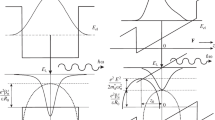Abstract
There has been an increasing interest in the study of the effect of electric field on the properties of semiconductor quantum dots. This is due to the fact that such systems provide a high degree of freedom in the control of the band structure and the binding energy of impurity states, which is important for instrumental applications. Of particular interest is the study of the effect of electric field on the A+ impurity states, which can form long-lived \({{A}^{ + }} + e\) complexes with nonequilibrium electrons. Variations in the magnitude of the external electric field can be used to control the binding energy of the A+ state, concentration of charge carriers, and optical properties of quasi-zero-dimensional structures. The purpose of this work is to theoretically study the effect of external electric field on the binding energy of a hole in the \({{A}^{ + }} + e\) impurity complex in a spherically symmetric quantum dot. The interaction of an electron in the ground state of a quantum dot and a hole localized at the A+ center is considered in the framework of the adiabatic approximation. The dispersion relation that determines the dependence of the binding energy of a hole in the \({{A}^{ + }} + e\) impurity complex in a spherically symmetric quantum dot on the magnitude of the external electric field is obtained in the model of the zero-radius potential in the approximation of effective mass. All curves are plotted for quantum dots based on InSb. An analytical solution of the problem of bound states of a hole in the \({{A}^{ + }} + e\) complex in a spherically symmetric quantum dot is obtained in the presence of an external electric field in the zero-radius-potential model in the adiabatic approximation. The centered and uncentered locations of the A+ center in a quantum dot are considered. It is shown that the curve of the field dependence of the binding energy of the A+ center has a characteristic maximum, the position of which is related to the dynamics of the adiabatic potential in the presence of an external electric field. It is shown that there is a threshold value of the external electric field at which the existence of the bound A+ state becomes impossible. The monotonic behavior of the dependence of the binding energy of the A+ state on the radius of the QD is violated for the uncentered A+ center. For certain values of the QD radius, the binding energy reaches maximum, which is due to coincidence of the position of the center and the minimum of the adiabatic potential.






Similar content being viewed by others
REFERENCES
Yu. N. Demkov and V. N. Ostrovskii, Zero-Range Potentials and Their Applications in Atomic Physics (Springer, New York, 1988). https://doi.org/10.1007/978-1-4684-5451-2
V. D. Krevchik and A. V. Levashov, Semiconductors 36, 208 (2002). https://doi.org/10.1134/1.1453440
N. S. Averkiev, A. E. Zhukov, Y. L. Ivanov, P. V. Petrov, et al., Semiconductors 38, 217 (2004). https://doi.org/10.1134/1.1648380
Yu. L. Ivanov, P. V. Petrov, A. A. Tonkikh, et al., Semiconductors 37, 1090 (2003). https://doi.org/10.1134/1.1610125
E. P. Sinyavskii and U. Yu. Kanarovskii, Fiz. Tverd. Tela 35 (6), 1641 (1993).
H.-Y. Zhou, S.-W. Gu, and Y.-M. Shi, Commun. Theor. Phys. 44 (2), 375 (2005).
J.-H. Yuan, W.-F. Xie, and L.-L. He, Commun. Theor. Phys. 52 (4), 710 (2009).
G. Murillo and N. Porras-Montenegro, Phys. Status Solidi B 220, 187 (2000).
E. Assaid, E. Feddi, M. Khaidar, et al., Phys. Scr. 63 (4), 329 (2001). https://doi.org/10.1238/Physica.Regular.063a00329
M. Ulaş, E. Cicek, and S. Senturk Dalgic, Phys. Status Solidi B 241, 2968 (2004).
E. C. Niculescu, Mod. Phys. Lett. B 15 (16), 545 (2001).
Sr. G. Jayam and K. Navaneethakrishman, Solid State Commun. 126, 681 (2003).
Al. L. Efros and A. L. Efros, Sov. Phys.-Semicond. 16 (7), 772 (1982).
V. D. Krevchik and A. V. Levashov, Phys. Solid State 48, 589 (2006). https://doi.org/10.1134/S1063783406030280
S. I. Pokutnii, Semiconductors 34, 1079 (2000). https://doi.org/10.1134/1.1309427
Funding
This work was supported by the Ministry of Science and Higher Education of the Russian Federation (grant no. 0748-2020-0012).
Author information
Authors and Affiliations
Corresponding author
Ethics declarations
The authors declare that there is no conflicts of interest.
Additional information
Translated by A. Chikishev
Rights and permissions
About this article
Cite this article
Levashov, A.V., Krevchik, V.D., Semenov, M.B. et al. Specific Features of Recombination Radiation in Quantum Dots with the A+ + e Impurity Complexes in the Presence of External Electric Field. Part I. Effect of External Electric Field on the Binding Energy of a Hole in the A+ + e Impurity Complex in a Spherically Symmetric Quantum Dot. Tech. Phys. 67, 508–515 (2022). https://doi.org/10.1134/S1063784222070064
Received:
Revised:
Accepted:
Published:
Issue Date:
DOI: https://doi.org/10.1134/S1063784222070064




